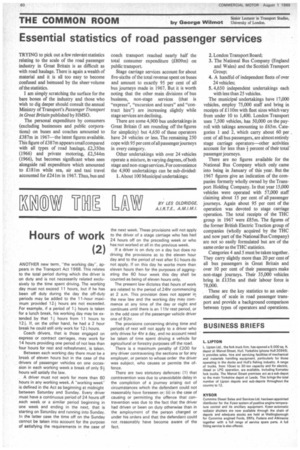THE COMMON ROOM
Page 62

If you've noticed an error in this article please click here to report it so we can fix it.
Essential statistics of road passenger services
TRYING to pick out a few relevint statistics relating to the scale of the road passenger industry in Great Britain is as difficult as with road haulage. There is again a wealth of material and it is all too easy to become confused and bemused by the sheer volume of the statistics.
I am simply scratching the surface for the bare bones of the industry and those who wish to dig deeper should consult the annual Ministry of Transport's Passenger Transport in Great Britain published by HMSO.
The personal expenditure by consumers (excluding businesses and public corporations) on buses and coaches amounted to £387m in 1967—the latest figures available. This figure of £387m appears small compared with all types of road haulage, £2,350m (1966) and private motoring, £2,544m (1966), but becomes significant when seen alongside rail expenditure which amounted to £181m while sea, air and taxi travel accounted for £241m in 1967. Thus, bus and
coach transport reached nearly half the total consumer expenditure (£809m) on public transport.
Stage carriage services account for about five-sixths of the total revenue spent on buses and amount to exactly 95 per cent of all bus journeys made in 1967. But it is worth noting that the other main divisions of bus business, non-stage services (that is "express", "excursion and tours" and "contract hire") are increasing slightly while stage services are declining.
There are some 4,900 bus undertakings in Great Britain (I am rounding off the figures for simplicity) but 4,650 of these operators have 24 vehicles or less. The remaining 250 cope with 95 per cent of all passenger journeys in every category.
Other undertakings with over 24 vehicles operate a mixture, in varying degrees, of both stage and non-stage services. For convenience the 4,900 undertakings can be sub-divided:
1. About 100 Municipal undertakings;
2. London Transport Board; 3. The National Bus Company (England and Wales) and the Scottish Transport Group; 4. A handful of independent fleets of over 24 vehicles; 5. 4,6 5 0 independent undertakings each with less than 25 vehicles.
The municipal undertakings have 17,000 vehicles, employ 75,000 staff and bring in receipts of illOm with fleet sizes which vary from under 10 to 1,400. London Transport uses 7,500 vehicles, has 50,000 on the payroll with takings amounting to £65m. Categories 1 and 2, which carry about 60 per . cent of all bus passengers, are almost entirely stage carriage operators—other activities account for less than percent of their total' passenger journeys.
There are no figures available for the National Bus Company which only came into being in January of this year. But the 1967 figures give an indication of the companies formerly wholly owned by the Transport Holding Company. In that year 15,000 vehicles were operated with 57,000 staff claiming about 15 per cent of all passenger journeys. Again about 95 per cent of the operation was devoted to stage carriage operation. The total receipts of the THC group in 1967 were £85m. The figures of the former British Electric Traction group of companies (wholly acquired by the THC and now part of the National Bus Company) are not so easily formulated but are of the same order as the THC statistics.
Categories 4 and 5 must be taken together. They carry slightly more than 20 per cent of all bus passengers in Great Britain and over 10 per cent of their passengers make non-stage journeys. Their 35,000 vehicles bring in £135m and their labour force is 78,000.
These are the key statistics to an understanding of scale in road passenger transport and provide a background comparison between types of operators and operations.


































































































